An Examination of Information Technology in Standard Chartered Bank
VerifiedAdded on 2023/01/13
|10
|3606
|93
Report
AI Summary
This report delves into the application of Information Technology (IT) within Standard Chartered Bank, a multinational financial institution. It begins with an introduction outlining the importance of IT in the current business landscape, followed by a literature review that explores the role of IT in retail, networking technologies, ethical and social considerations, and the significance of intranets and the internet in business operations. The analysis and discussion section examines different types of information systems utilized by Standard Chartered Bank, including transaction processing, management information, decision support, and executive support systems, highlighting their role in automating banking processes and ensuring efficient information management. Furthermore, it discusses the various networking technologies employed and addresses ethical and social issues related to IT use, along with the importance of intranet and internet. The report concludes by summarizing the key findings and emphasizing the crucial role of IT in enhancing the bank's efficiency, customer service, and overall competitiveness. The report highlights the importance of IT in improving communication, saving time and costs, and managing various business activities. It also underscores the significance of ethical considerations and adherence to regulations in the use of IT within the banking sector.
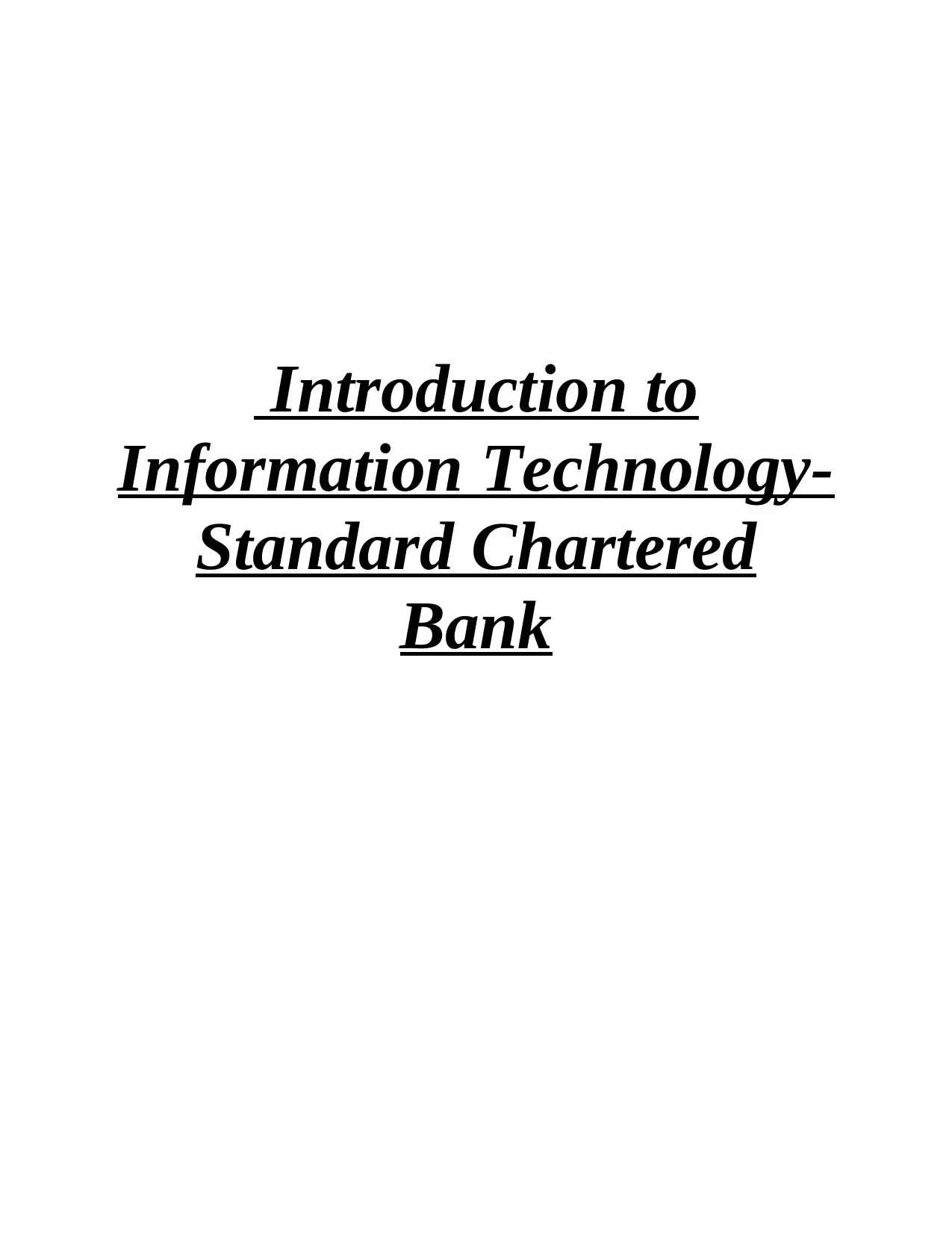
Introduction to
Information Technology-
Standard Chartered
Bank
Information Technology-
Standard Chartered
Bank
Paraphrase This Document
Need a fresh take? Get an instant paraphrase of this document with our AI Paraphraser
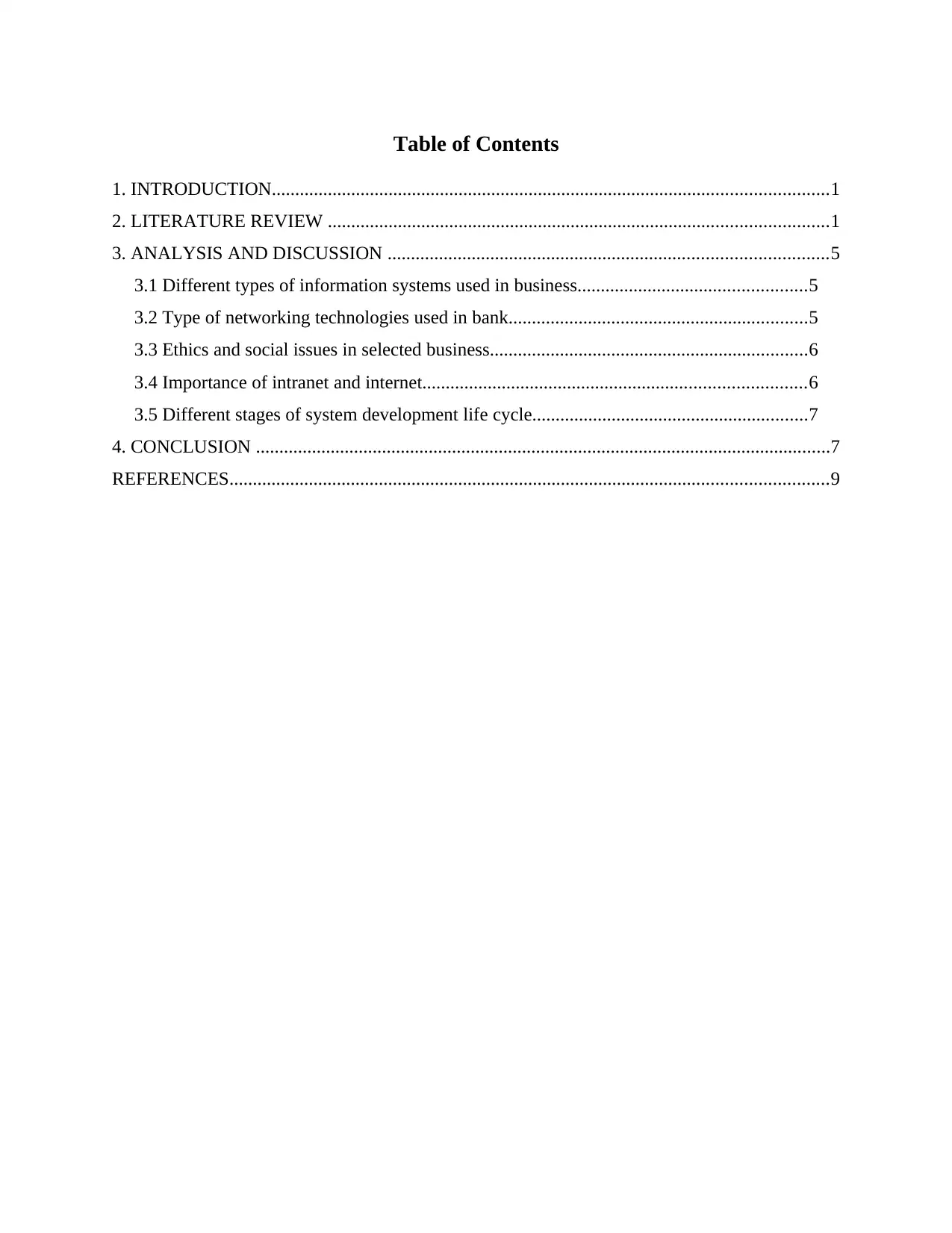
Table of Contents
1. INTRODUCTION.......................................................................................................................1
2. LITERATURE REVIEW ...........................................................................................................1
3. ANALYSIS AND DISCUSSION ..............................................................................................5
3.1 Different types of information systems used in business.................................................5
3.2 Type of networking technologies used in bank................................................................5
3.3 Ethics and social issues in selected business....................................................................6
3.4 Importance of intranet and internet..................................................................................6
3.5 Different stages of system development life cycle...........................................................7
4. CONCLUSION ...........................................................................................................................7
REFERENCES................................................................................................................................9
1. INTRODUCTION.......................................................................................................................1
2. LITERATURE REVIEW ...........................................................................................................1
3. ANALYSIS AND DISCUSSION ..............................................................................................5
3.1 Different types of information systems used in business.................................................5
3.2 Type of networking technologies used in bank................................................................5
3.3 Ethics and social issues in selected business....................................................................6
3.4 Importance of intranet and internet..................................................................................6
3.5 Different stages of system development life cycle...........................................................7
4. CONCLUSION ...........................................................................................................................7
REFERENCES................................................................................................................................9
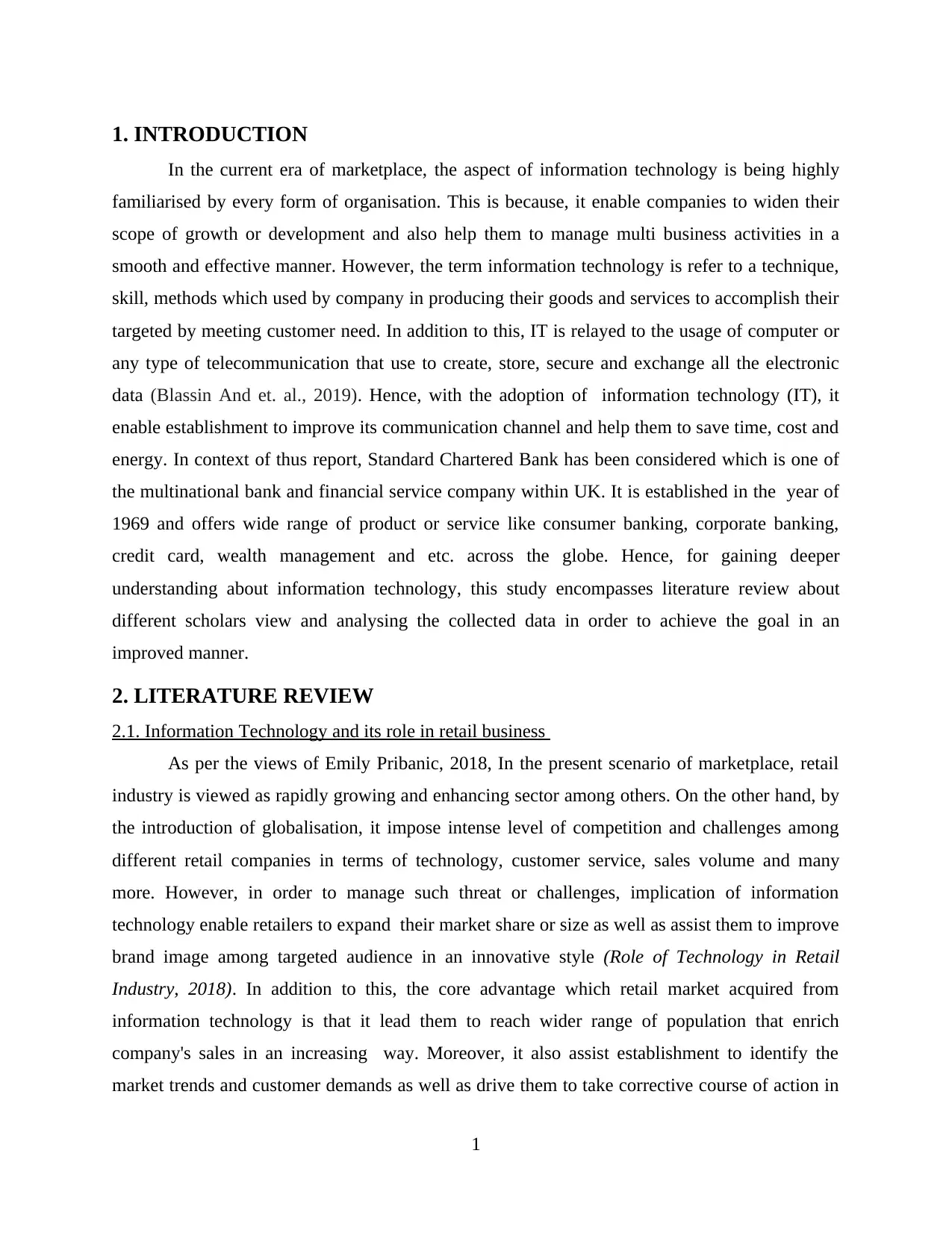
1. INTRODUCTION
In the current era of marketplace, the aspect of information technology is being highly
familiarised by every form of organisation. This is because, it enable companies to widen their
scope of growth or development and also help them to manage multi business activities in a
smooth and effective manner. However, the term information technology is refer to a technique,
skill, methods which used by company in producing their goods and services to accomplish their
targeted by meeting customer need. In addition to this, IT is relayed to the usage of computer or
any type of telecommunication that use to create, store, secure and exchange all the electronic
data (Blassin And et. al., 2019). Hence, with the adoption of information technology (IT), it
enable establishment to improve its communication channel and help them to save time, cost and
energy. In context of thus report, Standard Chartered Bank has been considered which is one of
the multinational bank and financial service company within UK. It is established in the year of
1969 and offers wide range of product or service like consumer banking, corporate banking,
credit card, wealth management and etc. across the globe. Hence, for gaining deeper
understanding about information technology, this study encompasses literature review about
different scholars view and analysing the collected data in order to achieve the goal in an
improved manner.
2. LITERATURE REVIEW
2.1. Information Technology and its role in retail business
As per the views of Emily Pribanic, 2018, In the present scenario of marketplace, retail
industry is viewed as rapidly growing and enhancing sector among others. On the other hand, by
the introduction of globalisation, it impose intense level of competition and challenges among
different retail companies in terms of technology, customer service, sales volume and many
more. However, in order to manage such threat or challenges, implication of information
technology enable retailers to expand their market share or size as well as assist them to improve
brand image among targeted audience in an innovative style (Role of Technology in Retail
Industry, 2018). In addition to this, the core advantage which retail market acquired from
information technology is that it lead them to reach wider range of population that enrich
company's sales in an increasing way. Moreover, it also assist establishment to identify the
market trends and customer demands as well as drive them to take corrective course of action in
1
In the current era of marketplace, the aspect of information technology is being highly
familiarised by every form of organisation. This is because, it enable companies to widen their
scope of growth or development and also help them to manage multi business activities in a
smooth and effective manner. However, the term information technology is refer to a technique,
skill, methods which used by company in producing their goods and services to accomplish their
targeted by meeting customer need. In addition to this, IT is relayed to the usage of computer or
any type of telecommunication that use to create, store, secure and exchange all the electronic
data (Blassin And et. al., 2019). Hence, with the adoption of information technology (IT), it
enable establishment to improve its communication channel and help them to save time, cost and
energy. In context of thus report, Standard Chartered Bank has been considered which is one of
the multinational bank and financial service company within UK. It is established in the year of
1969 and offers wide range of product or service like consumer banking, corporate banking,
credit card, wealth management and etc. across the globe. Hence, for gaining deeper
understanding about information technology, this study encompasses literature review about
different scholars view and analysing the collected data in order to achieve the goal in an
improved manner.
2. LITERATURE REVIEW
2.1. Information Technology and its role in retail business
As per the views of Emily Pribanic, 2018, In the present scenario of marketplace, retail
industry is viewed as rapidly growing and enhancing sector among others. On the other hand, by
the introduction of globalisation, it impose intense level of competition and challenges among
different retail companies in terms of technology, customer service, sales volume and many
more. However, in order to manage such threat or challenges, implication of information
technology enable retailers to expand their market share or size as well as assist them to improve
brand image among targeted audience in an innovative style (Role of Technology in Retail
Industry, 2018). In addition to this, the core advantage which retail market acquired from
information technology is that it lead them to reach wider range of population that enrich
company's sales in an increasing way. Moreover, it also assist establishment to identify the
market trends and customer demands as well as drive them to take corrective course of action in
1
⊘ This is a preview!⊘
Do you want full access?
Subscribe today to unlock all pages.

Trusted by 1+ million students worldwide
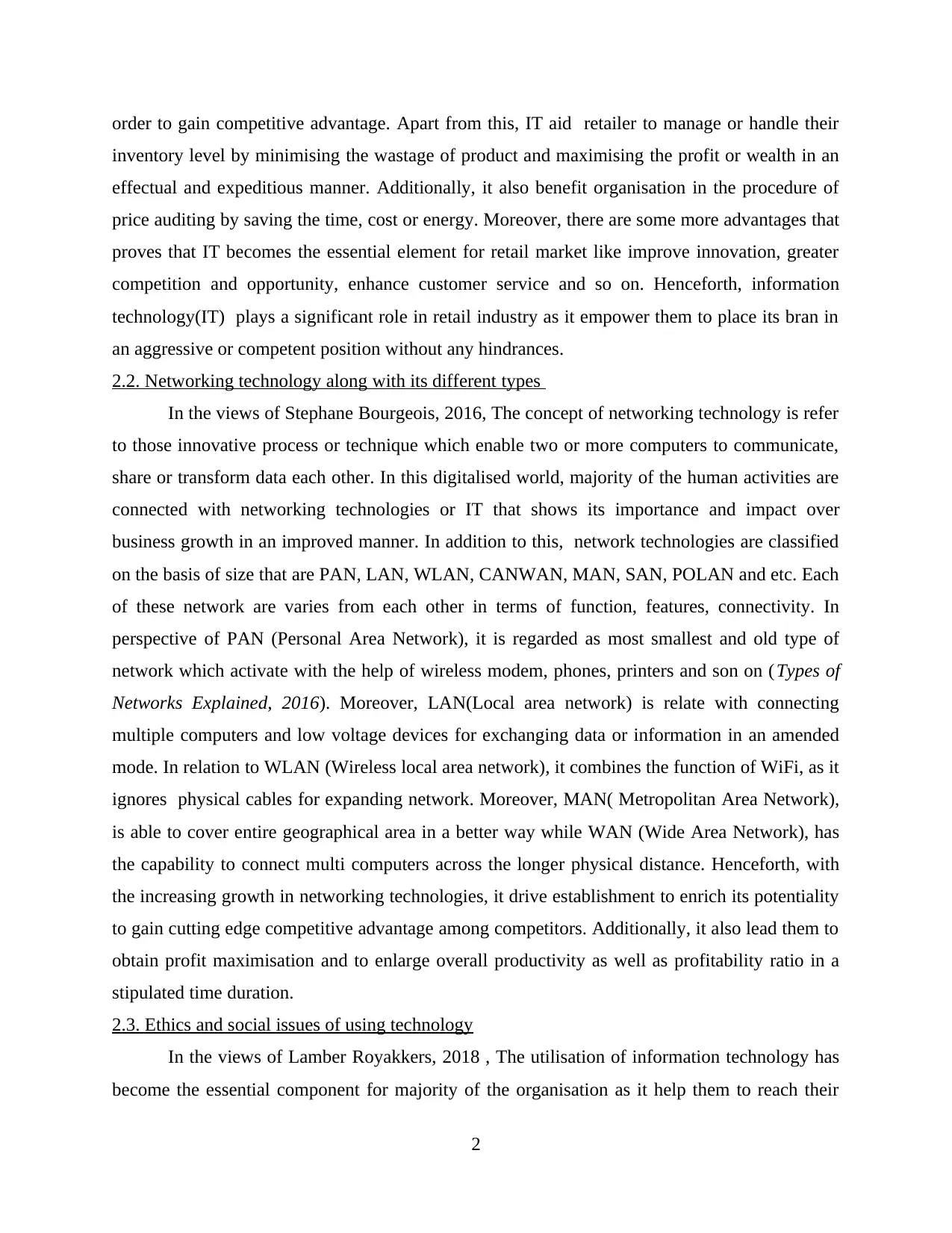
order to gain competitive advantage. Apart from this, IT aid retailer to manage or handle their
inventory level by minimising the wastage of product and maximising the profit or wealth in an
effectual and expeditious manner. Additionally, it also benefit organisation in the procedure of
price auditing by saving the time, cost or energy. Moreover, there are some more advantages that
proves that IT becomes the essential element for retail market like improve innovation, greater
competition and opportunity, enhance customer service and so on. Henceforth, information
technology(IT) plays a significant role in retail industry as it empower them to place its bran in
an aggressive or competent position without any hindrances.
2.2. Networking technology along with its different types
In the views of Stephane Bourgeois, 2016, The concept of networking technology is refer
to those innovative process or technique which enable two or more computers to communicate,
share or transform data each other. In this digitalised world, majority of the human activities are
connected with networking technologies or IT that shows its importance and impact over
business growth in an improved manner. In addition to this, network technologies are classified
on the basis of size that are PAN, LAN, WLAN, CANWAN, MAN, SAN, POLAN and etc. Each
of these network are varies from each other in terms of function, features, connectivity. In
perspective of PAN (Personal Area Network), it is regarded as most smallest and old type of
network which activate with the help of wireless modem, phones, printers and son on (Types of
Networks Explained, 2016). Moreover, LAN(Local area network) is relate with connecting
multiple computers and low voltage devices for exchanging data or information in an amended
mode. In relation to WLAN (Wireless local area network), it combines the function of WiFi, as it
ignores physical cables for expanding network. Moreover, MAN( Metropolitan Area Network),
is able to cover entire geographical area in a better way while WAN (Wide Area Network), has
the capability to connect multi computers across the longer physical distance. Henceforth, with
the increasing growth in networking technologies, it drive establishment to enrich its potentiality
to gain cutting edge competitive advantage among competitors. Additionally, it also lead them to
obtain profit maximisation and to enlarge overall productivity as well as profitability ratio in a
stipulated time duration.
2.3. Ethics and social issues of using technology
In the views of Lamber Royakkers, 2018 , The utilisation of information technology has
become the essential component for majority of the organisation as it help them to reach their
2
inventory level by minimising the wastage of product and maximising the profit or wealth in an
effectual and expeditious manner. Additionally, it also benefit organisation in the procedure of
price auditing by saving the time, cost or energy. Moreover, there are some more advantages that
proves that IT becomes the essential element for retail market like improve innovation, greater
competition and opportunity, enhance customer service and so on. Henceforth, information
technology(IT) plays a significant role in retail industry as it empower them to place its bran in
an aggressive or competent position without any hindrances.
2.2. Networking technology along with its different types
In the views of Stephane Bourgeois, 2016, The concept of networking technology is refer
to those innovative process or technique which enable two or more computers to communicate,
share or transform data each other. In this digitalised world, majority of the human activities are
connected with networking technologies or IT that shows its importance and impact over
business growth in an improved manner. In addition to this, network technologies are classified
on the basis of size that are PAN, LAN, WLAN, CANWAN, MAN, SAN, POLAN and etc. Each
of these network are varies from each other in terms of function, features, connectivity. In
perspective of PAN (Personal Area Network), it is regarded as most smallest and old type of
network which activate with the help of wireless modem, phones, printers and son on (Types of
Networks Explained, 2016). Moreover, LAN(Local area network) is relate with connecting
multiple computers and low voltage devices for exchanging data or information in an amended
mode. In relation to WLAN (Wireless local area network), it combines the function of WiFi, as it
ignores physical cables for expanding network. Moreover, MAN( Metropolitan Area Network),
is able to cover entire geographical area in a better way while WAN (Wide Area Network), has
the capability to connect multi computers across the longer physical distance. Henceforth, with
the increasing growth in networking technologies, it drive establishment to enrich its potentiality
to gain cutting edge competitive advantage among competitors. Additionally, it also lead them to
obtain profit maximisation and to enlarge overall productivity as well as profitability ratio in a
stipulated time duration.
2.3. Ethics and social issues of using technology
In the views of Lamber Royakkers, 2018 , The utilisation of information technology has
become the essential component for majority of the organisation as it help them to reach their
2
Paraphrase This Document
Need a fresh take? Get an instant paraphrase of this document with our AI Paraphraser
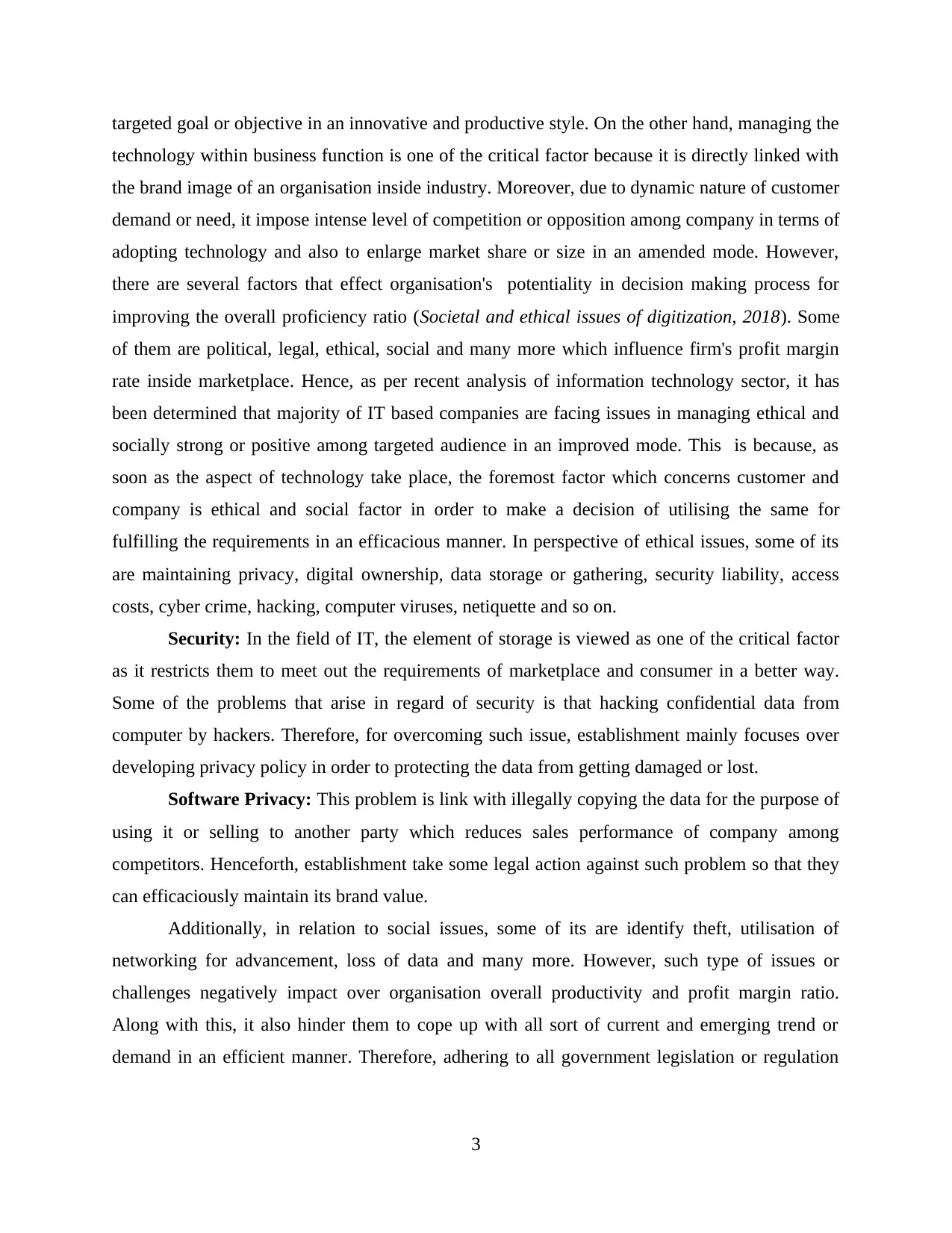
targeted goal or objective in an innovative and productive style. On the other hand, managing the
technology within business function is one of the critical factor because it is directly linked with
the brand image of an organisation inside industry. Moreover, due to dynamic nature of customer
demand or need, it impose intense level of competition or opposition among company in terms of
adopting technology and also to enlarge market share or size in an amended mode. However,
there are several factors that effect organisation's potentiality in decision making process for
improving the overall proficiency ratio (Societal and ethical issues of digitization, 2018). Some
of them are political, legal, ethical, social and many more which influence firm's profit margin
rate inside marketplace. Hence, as per recent analysis of information technology sector, it has
been determined that majority of IT based companies are facing issues in managing ethical and
socially strong or positive among targeted audience in an improved mode. This is because, as
soon as the aspect of technology take place, the foremost factor which concerns customer and
company is ethical and social factor in order to make a decision of utilising the same for
fulfilling the requirements in an efficacious manner. In perspective of ethical issues, some of its
are maintaining privacy, digital ownership, data storage or gathering, security liability, access
costs, cyber crime, hacking, computer viruses, netiquette and so on.
Security: In the field of IT, the element of storage is viewed as one of the critical factor
as it restricts them to meet out the requirements of marketplace and consumer in a better way.
Some of the problems that arise in regard of security is that hacking confidential data from
computer by hackers. Therefore, for overcoming such issue, establishment mainly focuses over
developing privacy policy in order to protecting the data from getting damaged or lost.
Software Privacy: This problem is link with illegally copying the data for the purpose of
using it or selling to another party which reduces sales performance of company among
competitors. Henceforth, establishment take some legal action against such problem so that they
can efficaciously maintain its brand value.
Additionally, in relation to social issues, some of its are identify theft, utilisation of
networking for advancement, loss of data and many more. However, such type of issues or
challenges negatively impact over organisation overall productivity and profit margin ratio.
Along with this, it also hinder them to cope up with all sort of current and emerging trend or
demand in an efficient manner. Therefore, adhering to all government legislation or regulation
3
technology within business function is one of the critical factor because it is directly linked with
the brand image of an organisation inside industry. Moreover, due to dynamic nature of customer
demand or need, it impose intense level of competition or opposition among company in terms of
adopting technology and also to enlarge market share or size in an amended mode. However,
there are several factors that effect organisation's potentiality in decision making process for
improving the overall proficiency ratio (Societal and ethical issues of digitization, 2018). Some
of them are political, legal, ethical, social and many more which influence firm's profit margin
rate inside marketplace. Hence, as per recent analysis of information technology sector, it has
been determined that majority of IT based companies are facing issues in managing ethical and
socially strong or positive among targeted audience in an improved mode. This is because, as
soon as the aspect of technology take place, the foremost factor which concerns customer and
company is ethical and social factor in order to make a decision of utilising the same for
fulfilling the requirements in an efficacious manner. In perspective of ethical issues, some of its
are maintaining privacy, digital ownership, data storage or gathering, security liability, access
costs, cyber crime, hacking, computer viruses, netiquette and so on.
Security: In the field of IT, the element of storage is viewed as one of the critical factor
as it restricts them to meet out the requirements of marketplace and consumer in a better way.
Some of the problems that arise in regard of security is that hacking confidential data from
computer by hackers. Therefore, for overcoming such issue, establishment mainly focuses over
developing privacy policy in order to protecting the data from getting damaged or lost.
Software Privacy: This problem is link with illegally copying the data for the purpose of
using it or selling to another party which reduces sales performance of company among
competitors. Henceforth, establishment take some legal action against such problem so that they
can efficaciously maintain its brand value.
Additionally, in relation to social issues, some of its are identify theft, utilisation of
networking for advancement, loss of data and many more. However, such type of issues or
challenges negatively impact over organisation overall productivity and profit margin ratio.
Along with this, it also hinder them to cope up with all sort of current and emerging trend or
demand in an efficient manner. Therefore, adhering to all government legislation or regulation
3
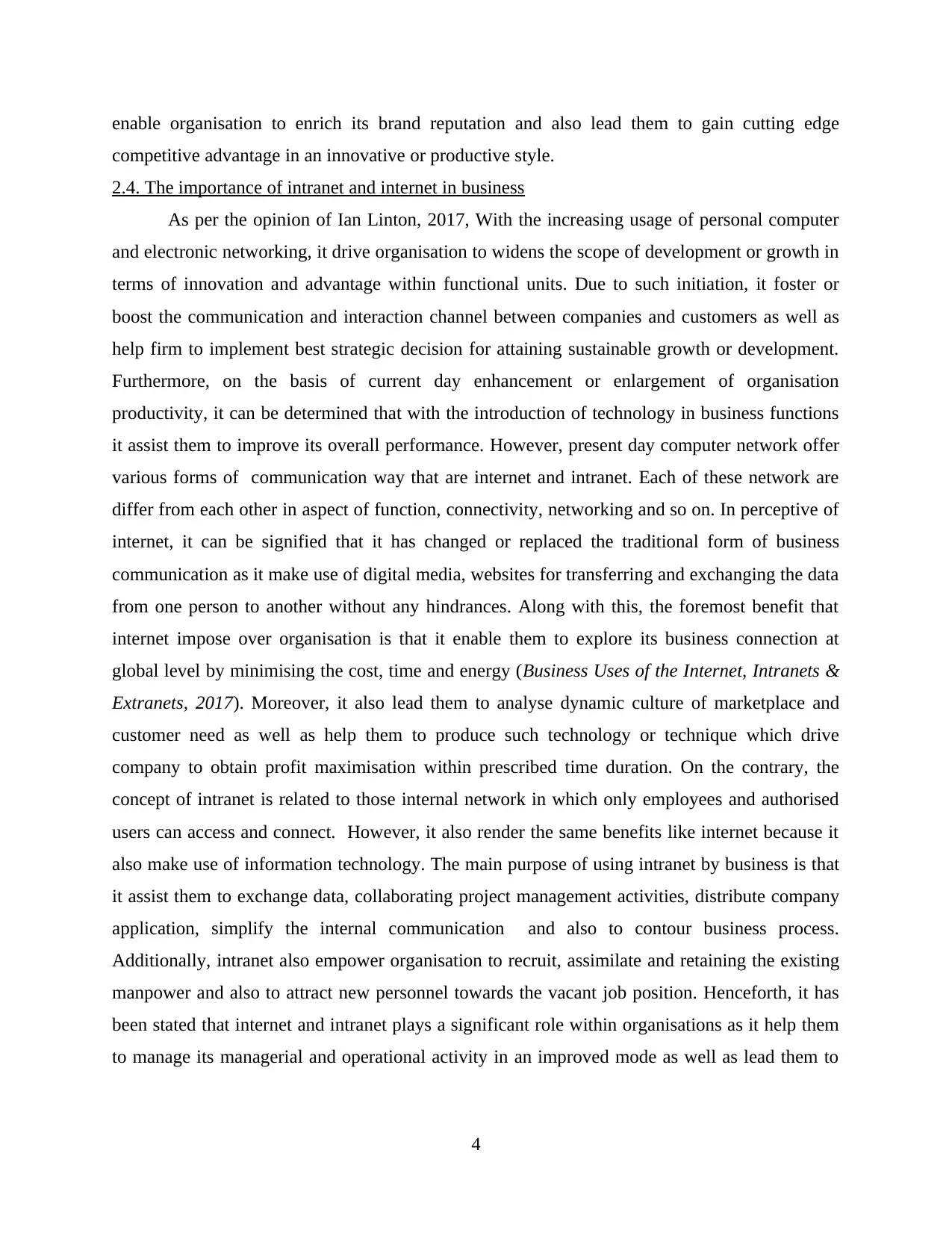
enable organisation to enrich its brand reputation and also lead them to gain cutting edge
competitive advantage in an innovative or productive style.
2.4. The importance of intranet and internet in business
As per the opinion of Ian Linton, 2017, With the increasing usage of personal computer
and electronic networking, it drive organisation to widens the scope of development or growth in
terms of innovation and advantage within functional units. Due to such initiation, it foster or
boost the communication and interaction channel between companies and customers as well as
help firm to implement best strategic decision for attaining sustainable growth or development.
Furthermore, on the basis of current day enhancement or enlargement of organisation
productivity, it can be determined that with the introduction of technology in business functions
it assist them to improve its overall performance. However, present day computer network offer
various forms of communication way that are internet and intranet. Each of these network are
differ from each other in aspect of function, connectivity, networking and so on. In perceptive of
internet, it can be signified that it has changed or replaced the traditional form of business
communication as it make use of digital media, websites for transferring and exchanging the data
from one person to another without any hindrances. Along with this, the foremost benefit that
internet impose over organisation is that it enable them to explore its business connection at
global level by minimising the cost, time and energy (Business Uses of the Internet, Intranets &
Extranets, 2017). Moreover, it also lead them to analyse dynamic culture of marketplace and
customer need as well as help them to produce such technology or technique which drive
company to obtain profit maximisation within prescribed time duration. On the contrary, the
concept of intranet is related to those internal network in which only employees and authorised
users can access and connect. However, it also render the same benefits like internet because it
also make use of information technology. The main purpose of using intranet by business is that
it assist them to exchange data, collaborating project management activities, distribute company
application, simplify the internal communication and also to contour business process.
Additionally, intranet also empower organisation to recruit, assimilate and retaining the existing
manpower and also to attract new personnel towards the vacant job position. Henceforth, it has
been stated that internet and intranet plays a significant role within organisations as it help them
to manage its managerial and operational activity in an improved mode as well as lead them to
4
competitive advantage in an innovative or productive style.
2.4. The importance of intranet and internet in business
As per the opinion of Ian Linton, 2017, With the increasing usage of personal computer
and electronic networking, it drive organisation to widens the scope of development or growth in
terms of innovation and advantage within functional units. Due to such initiation, it foster or
boost the communication and interaction channel between companies and customers as well as
help firm to implement best strategic decision for attaining sustainable growth or development.
Furthermore, on the basis of current day enhancement or enlargement of organisation
productivity, it can be determined that with the introduction of technology in business functions
it assist them to improve its overall performance. However, present day computer network offer
various forms of communication way that are internet and intranet. Each of these network are
differ from each other in aspect of function, connectivity, networking and so on. In perceptive of
internet, it can be signified that it has changed or replaced the traditional form of business
communication as it make use of digital media, websites for transferring and exchanging the data
from one person to another without any hindrances. Along with this, the foremost benefit that
internet impose over organisation is that it enable them to explore its business connection at
global level by minimising the cost, time and energy (Business Uses of the Internet, Intranets &
Extranets, 2017). Moreover, it also lead them to analyse dynamic culture of marketplace and
customer need as well as help them to produce such technology or technique which drive
company to obtain profit maximisation within prescribed time duration. On the contrary, the
concept of intranet is related to those internal network in which only employees and authorised
users can access and connect. However, it also render the same benefits like internet because it
also make use of information technology. The main purpose of using intranet by business is that
it assist them to exchange data, collaborating project management activities, distribute company
application, simplify the internal communication and also to contour business process.
Additionally, intranet also empower organisation to recruit, assimilate and retaining the existing
manpower and also to attract new personnel towards the vacant job position. Henceforth, it has
been stated that internet and intranet plays a significant role within organisations as it help them
to manage its managerial and operational activity in an improved mode as well as lead them to
4
⊘ This is a preview!⊘
Do you want full access?
Subscribe today to unlock all pages.

Trusted by 1+ million students worldwide
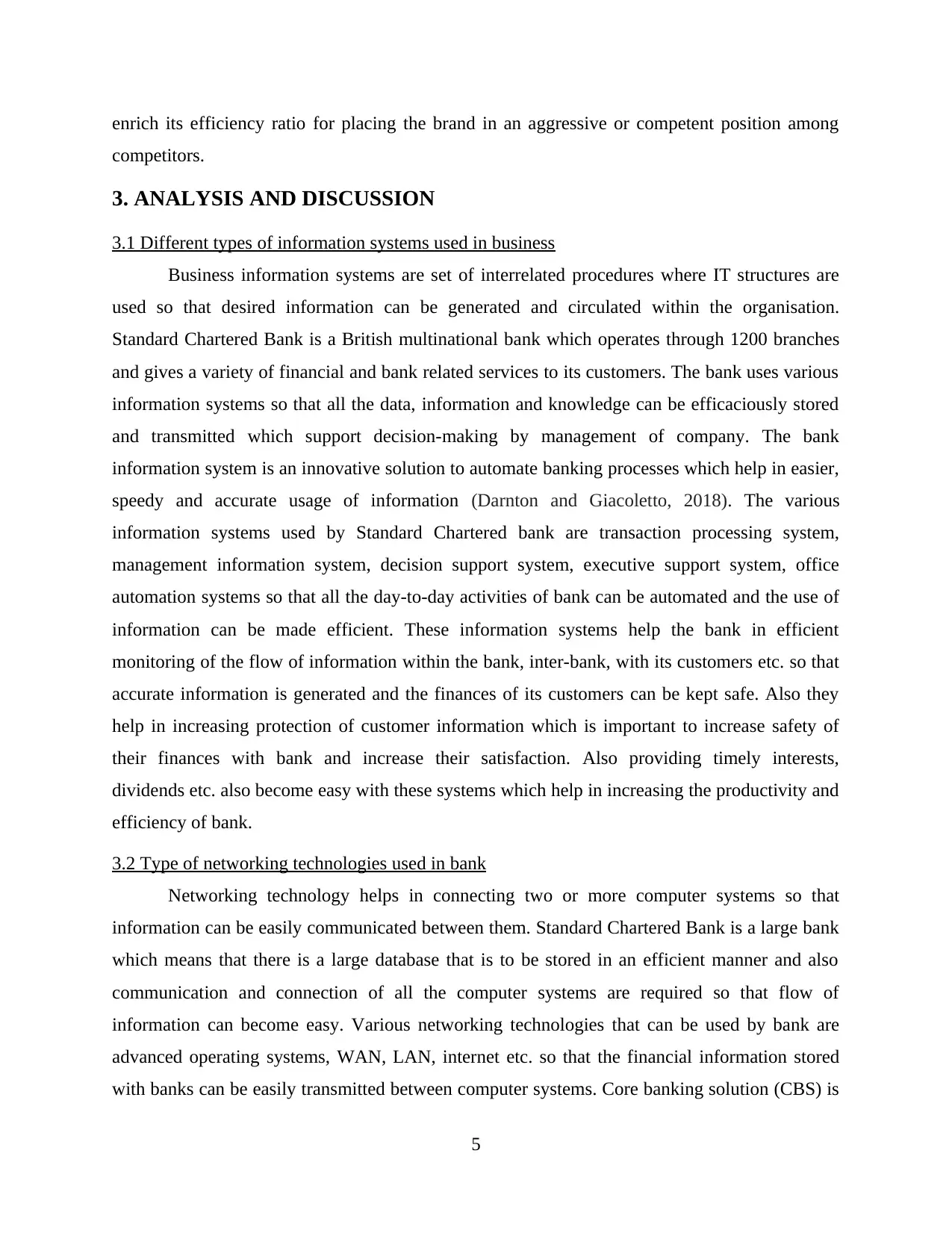
enrich its efficiency ratio for placing the brand in an aggressive or competent position among
competitors.
3. ANALYSIS AND DISCUSSION
3.1 Different types of information systems used in business
Business information systems are set of interrelated procedures where IT structures are
used so that desired information can be generated and circulated within the organisation.
Standard Chartered Bank is a British multinational bank which operates through 1200 branches
and gives a variety of financial and bank related services to its customers. The bank uses various
information systems so that all the data, information and knowledge can be efficaciously stored
and transmitted which support decision-making by management of company. The bank
information system is an innovative solution to automate banking processes which help in easier,
speedy and accurate usage of information (Darnton and Giacoletto, 2018). The various
information systems used by Standard Chartered bank are transaction processing system,
management information system, decision support system, executive support system, office
automation systems so that all the day-to-day activities of bank can be automated and the use of
information can be made efficient. These information systems help the bank in efficient
monitoring of the flow of information within the bank, inter-bank, with its customers etc. so that
accurate information is generated and the finances of its customers can be kept safe. Also they
help in increasing protection of customer information which is important to increase safety of
their finances with bank and increase their satisfaction. Also providing timely interests,
dividends etc. also become easy with these systems which help in increasing the productivity and
efficiency of bank.
3.2 Type of networking technologies used in bank
Networking technology helps in connecting two or more computer systems so that
information can be easily communicated between them. Standard Chartered Bank is a large bank
which means that there is a large database that is to be stored in an efficient manner and also
communication and connection of all the computer systems are required so that flow of
information can become easy. Various networking technologies that can be used by bank are
advanced operating systems, WAN, LAN, internet etc. so that the financial information stored
with banks can be easily transmitted between computer systems. Core banking solution (CBS) is
5
competitors.
3. ANALYSIS AND DISCUSSION
3.1 Different types of information systems used in business
Business information systems are set of interrelated procedures where IT structures are
used so that desired information can be generated and circulated within the organisation.
Standard Chartered Bank is a British multinational bank which operates through 1200 branches
and gives a variety of financial and bank related services to its customers. The bank uses various
information systems so that all the data, information and knowledge can be efficaciously stored
and transmitted which support decision-making by management of company. The bank
information system is an innovative solution to automate banking processes which help in easier,
speedy and accurate usage of information (Darnton and Giacoletto, 2018). The various
information systems used by Standard Chartered bank are transaction processing system,
management information system, decision support system, executive support system, office
automation systems so that all the day-to-day activities of bank can be automated and the use of
information can be made efficient. These information systems help the bank in efficient
monitoring of the flow of information within the bank, inter-bank, with its customers etc. so that
accurate information is generated and the finances of its customers can be kept safe. Also they
help in increasing protection of customer information which is important to increase safety of
their finances with bank and increase their satisfaction. Also providing timely interests,
dividends etc. also become easy with these systems which help in increasing the productivity and
efficiency of bank.
3.2 Type of networking technologies used in bank
Networking technology helps in connecting two or more computer systems so that
information can be easily communicated between them. Standard Chartered Bank is a large bank
which means that there is a large database that is to be stored in an efficient manner and also
communication and connection of all the computer systems are required so that flow of
information can become easy. Various networking technologies that can be used by bank are
advanced operating systems, WAN, LAN, internet etc. so that the financial information stored
with banks can be easily transmitted between computer systems. Core banking solution (CBS) is
5
Paraphrase This Document
Need a fresh take? Get an instant paraphrase of this document with our AI Paraphraser
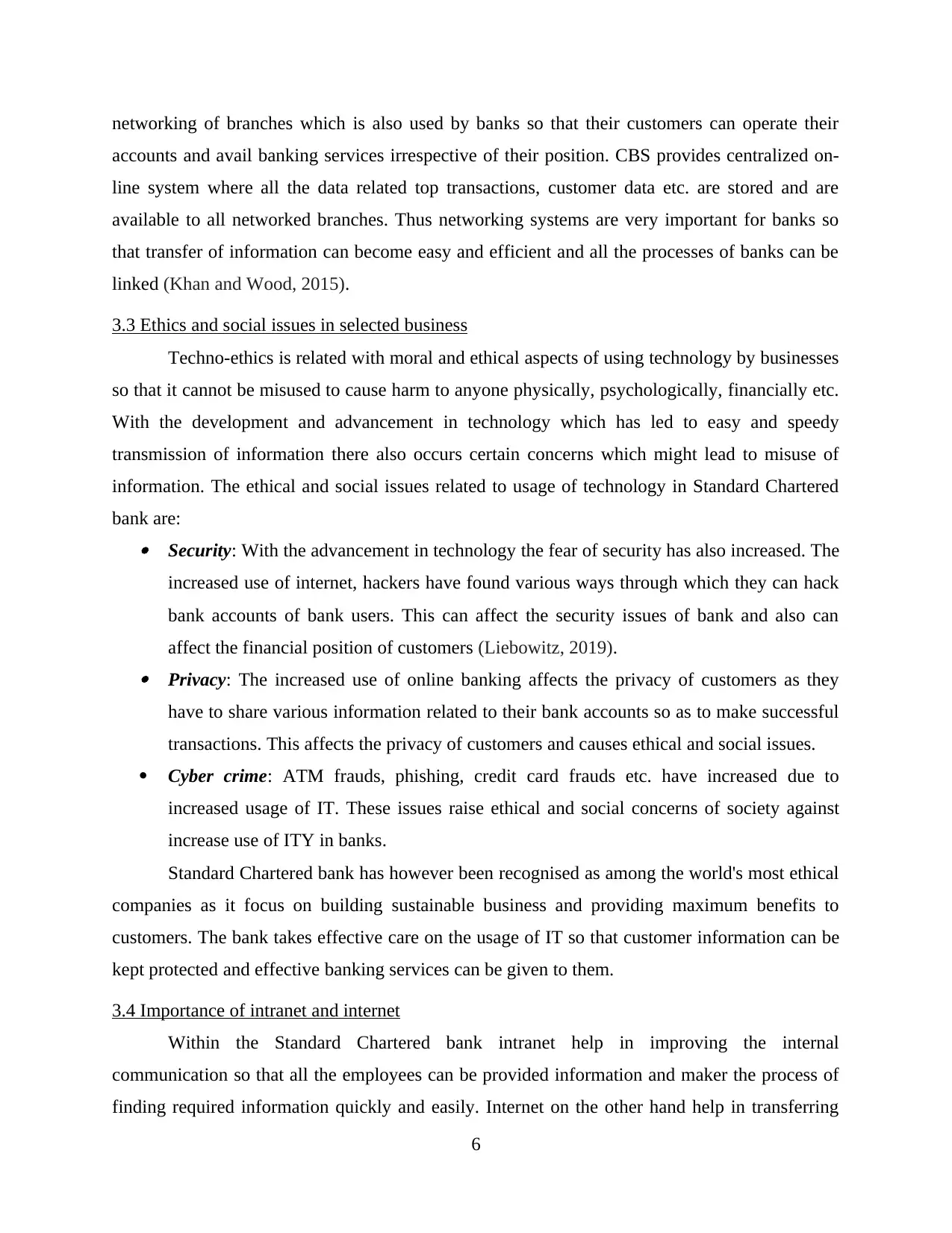
networking of branches which is also used by banks so that their customers can operate their
accounts and avail banking services irrespective of their position. CBS provides centralized on-
line system where all the data related top transactions, customer data etc. are stored and are
available to all networked branches. Thus networking systems are very important for banks so
that transfer of information can become easy and efficient and all the processes of banks can be
linked (Khan and Wood, 2015).
3.3 Ethics and social issues in selected business
Techno-ethics is related with moral and ethical aspects of using technology by businesses
so that it cannot be misused to cause harm to anyone physically, psychologically, financially etc.
With the development and advancement in technology which has led to easy and speedy
transmission of information there also occurs certain concerns which might lead to misuse of
information. The ethical and social issues related to usage of technology in Standard Chartered
bank are: Security: With the advancement in technology the fear of security has also increased. The
increased use of internet, hackers have found various ways through which they can hack
bank accounts of bank users. This can affect the security issues of bank and also can
affect the financial position of customers (Liebowitz, 2019). Privacy: The increased use of online banking affects the privacy of customers as they
have to share various information related to their bank accounts so as to make successful
transactions. This affects the privacy of customers and causes ethical and social issues.
Cyber crime: ATM frauds, phishing, credit card frauds etc. have increased due to
increased usage of IT. These issues raise ethical and social concerns of society against
increase use of ITY in banks.
Standard Chartered bank has however been recognised as among the world's most ethical
companies as it focus on building sustainable business and providing maximum benefits to
customers. The bank takes effective care on the usage of IT so that customer information can be
kept protected and effective banking services can be given to them.
3.4 Importance of intranet and internet
Within the Standard Chartered bank intranet help in improving the internal
communication so that all the employees can be provided information and maker the process of
finding required information quickly and easily. Internet on the other hand help in transferring
6
accounts and avail banking services irrespective of their position. CBS provides centralized on-
line system where all the data related top transactions, customer data etc. are stored and are
available to all networked branches. Thus networking systems are very important for banks so
that transfer of information can become easy and efficient and all the processes of banks can be
linked (Khan and Wood, 2015).
3.3 Ethics and social issues in selected business
Techno-ethics is related with moral and ethical aspects of using technology by businesses
so that it cannot be misused to cause harm to anyone physically, psychologically, financially etc.
With the development and advancement in technology which has led to easy and speedy
transmission of information there also occurs certain concerns which might lead to misuse of
information. The ethical and social issues related to usage of technology in Standard Chartered
bank are: Security: With the advancement in technology the fear of security has also increased. The
increased use of internet, hackers have found various ways through which they can hack
bank accounts of bank users. This can affect the security issues of bank and also can
affect the financial position of customers (Liebowitz, 2019). Privacy: The increased use of online banking affects the privacy of customers as they
have to share various information related to their bank accounts so as to make successful
transactions. This affects the privacy of customers and causes ethical and social issues.
Cyber crime: ATM frauds, phishing, credit card frauds etc. have increased due to
increased usage of IT. These issues raise ethical and social concerns of society against
increase use of ITY in banks.
Standard Chartered bank has however been recognised as among the world's most ethical
companies as it focus on building sustainable business and providing maximum benefits to
customers. The bank takes effective care on the usage of IT so that customer information can be
kept protected and effective banking services can be given to them.
3.4 Importance of intranet and internet
Within the Standard Chartered bank intranet help in improving the internal
communication so that all the employees can be provided information and maker the process of
finding required information quickly and easily. Internet on the other hand help in transferring
6
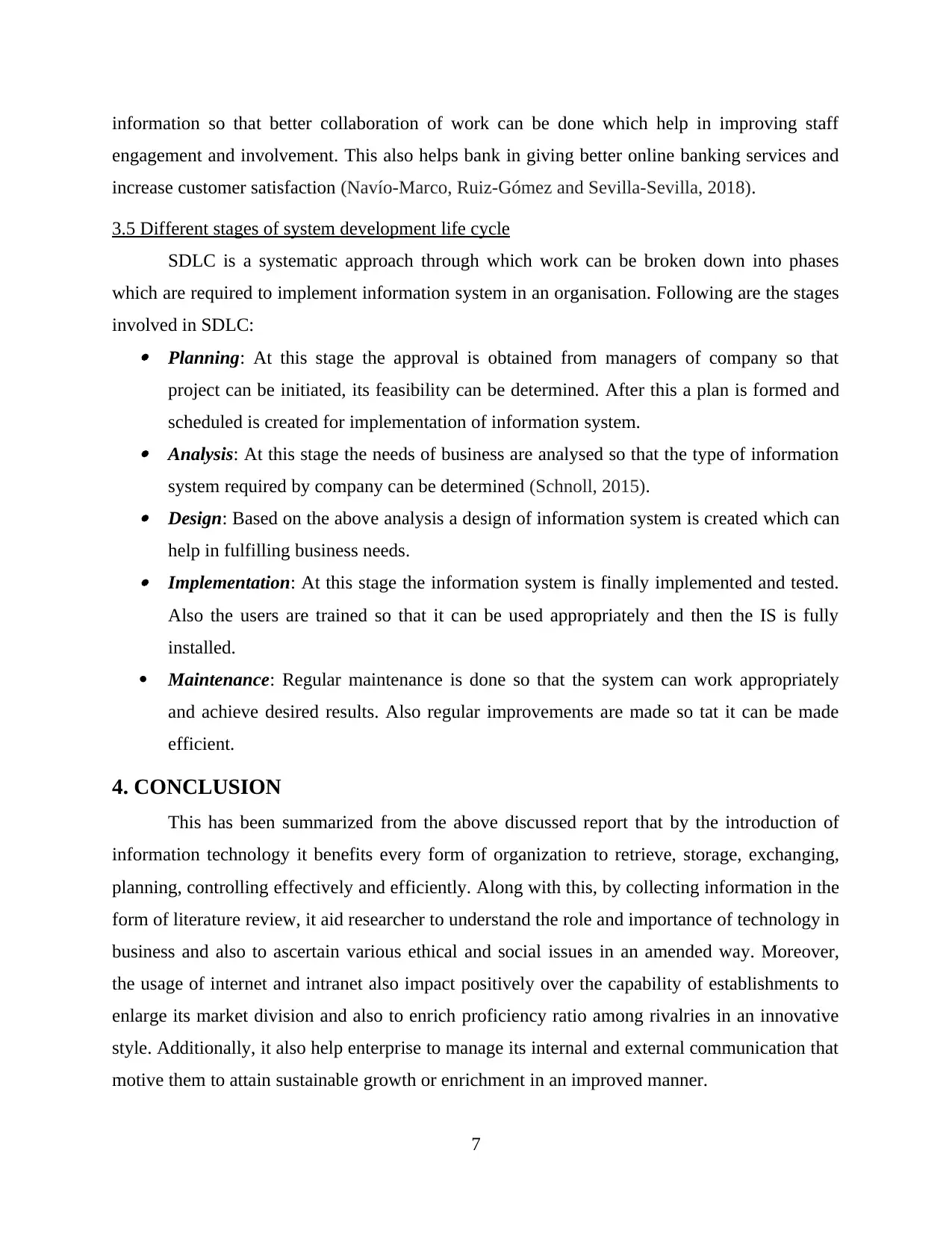
information so that better collaboration of work can be done which help in improving staff
engagement and involvement. This also helps bank in giving better online banking services and
increase customer satisfaction (Navío-Marco, Ruiz-Gómez and Sevilla-Sevilla, 2018).
3.5 Different stages of system development life cycle
SDLC is a systematic approach through which work can be broken down into phases
which are required to implement information system in an organisation. Following are the stages
involved in SDLC: Planning: At this stage the approval is obtained from managers of company so that
project can be initiated, its feasibility can be determined. After this a plan is formed and
scheduled is created for implementation of information system. Analysis: At this stage the needs of business are analysed so that the type of information
system required by company can be determined (Schnoll, 2015). Design: Based on the above analysis a design of information system is created which can
help in fulfilling business needs. Implementation: At this stage the information system is finally implemented and tested.
Also the users are trained so that it can be used appropriately and then the IS is fully
installed.
Maintenance: Regular maintenance is done so that the system can work appropriately
and achieve desired results. Also regular improvements are made so tat it can be made
efficient.
4. CONCLUSION
This has been summarized from the above discussed report that by the introduction of
information technology it benefits every form of organization to retrieve, storage, exchanging,
planning, controlling effectively and efficiently. Along with this, by collecting information in the
form of literature review, it aid researcher to understand the role and importance of technology in
business and also to ascertain various ethical and social issues in an amended way. Moreover,
the usage of internet and intranet also impact positively over the capability of establishments to
enlarge its market division and also to enrich proficiency ratio among rivalries in an innovative
style. Additionally, it also help enterprise to manage its internal and external communication that
motive them to attain sustainable growth or enrichment in an improved manner.
7
engagement and involvement. This also helps bank in giving better online banking services and
increase customer satisfaction (Navío-Marco, Ruiz-Gómez and Sevilla-Sevilla, 2018).
3.5 Different stages of system development life cycle
SDLC is a systematic approach through which work can be broken down into phases
which are required to implement information system in an organisation. Following are the stages
involved in SDLC: Planning: At this stage the approval is obtained from managers of company so that
project can be initiated, its feasibility can be determined. After this a plan is formed and
scheduled is created for implementation of information system. Analysis: At this stage the needs of business are analysed so that the type of information
system required by company can be determined (Schnoll, 2015). Design: Based on the above analysis a design of information system is created which can
help in fulfilling business needs. Implementation: At this stage the information system is finally implemented and tested.
Also the users are trained so that it can be used appropriately and then the IS is fully
installed.
Maintenance: Regular maintenance is done so that the system can work appropriately
and achieve desired results. Also regular improvements are made so tat it can be made
efficient.
4. CONCLUSION
This has been summarized from the above discussed report that by the introduction of
information technology it benefits every form of organization to retrieve, storage, exchanging,
planning, controlling effectively and efficiently. Along with this, by collecting information in the
form of literature review, it aid researcher to understand the role and importance of technology in
business and also to ascertain various ethical and social issues in an amended way. Moreover,
the usage of internet and intranet also impact positively over the capability of establishments to
enlarge its market division and also to enrich proficiency ratio among rivalries in an innovative
style. Additionally, it also help enterprise to manage its internal and external communication that
motive them to attain sustainable growth or enrichment in an improved manner.
7
⊘ This is a preview!⊘
Do you want full access?
Subscribe today to unlock all pages.

Trusted by 1+ million students worldwide
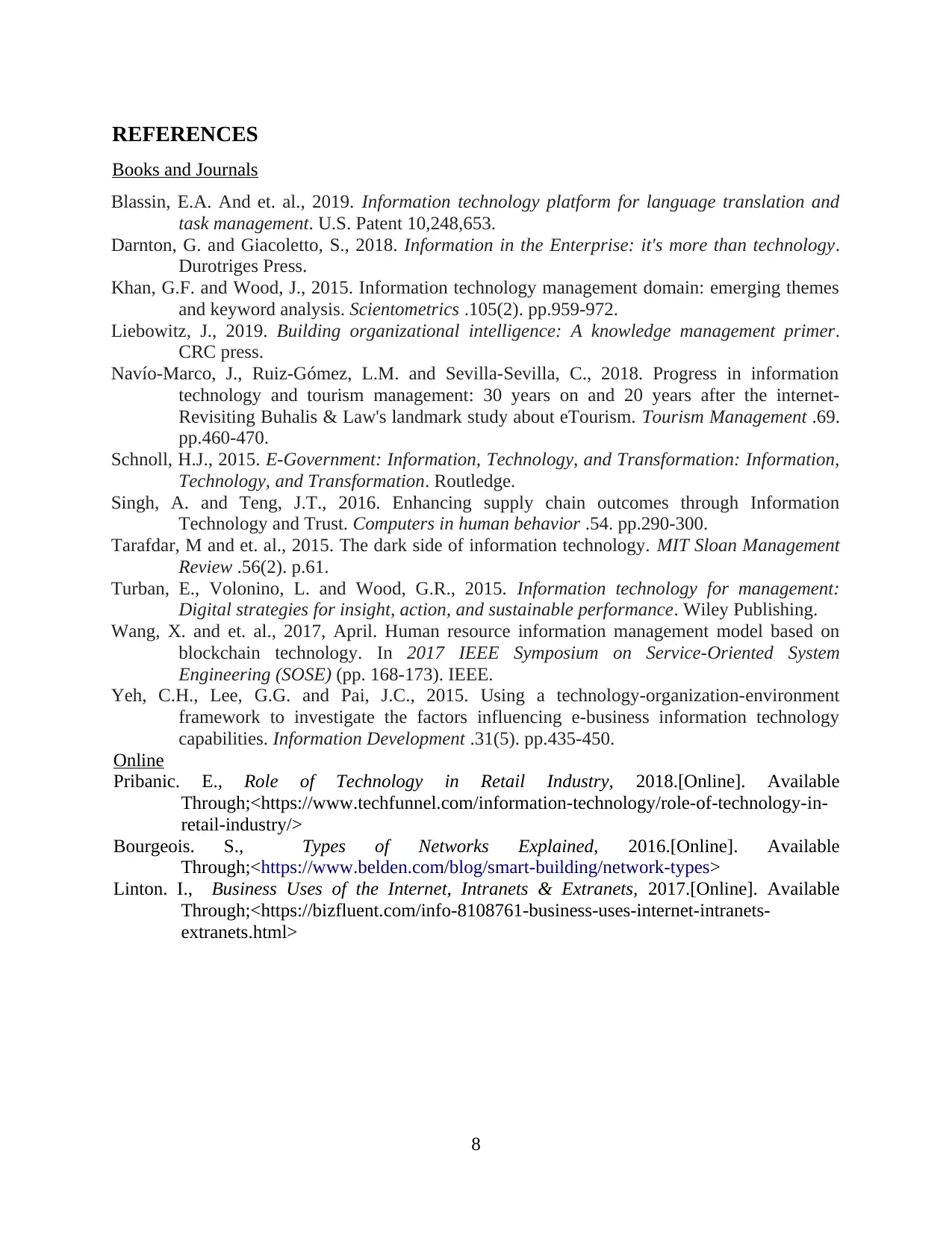
REFERENCES
Books and Journals
Blassin, E.A. And et. al., 2019. Information technology platform for language translation and
task management. U.S. Patent 10,248,653.
Darnton, G. and Giacoletto, S., 2018. Information in the Enterprise: it's more than technology.
Durotriges Press.
Khan, G.F. and Wood, J., 2015. Information technology management domain: emerging themes
and keyword analysis. Scientometrics .105(2). pp.959-972.
Liebowitz, J., 2019. Building organizational intelligence: A knowledge management primer.
CRC press.
Navío-Marco, J., Ruiz-Gómez, L.M. and Sevilla-Sevilla, C., 2018. Progress in information
technology and tourism management: 30 years on and 20 years after the internet-
Revisiting Buhalis & Law's landmark study about eTourism. Tourism Management .69.
pp.460-470.
Schnoll, H.J., 2015. E-Government: Information, Technology, and Transformation: Information,
Technology, and Transformation. Routledge.
Singh, A. and Teng, J.T., 2016. Enhancing supply chain outcomes through Information
Technology and Trust. Computers in human behavior .54. pp.290-300.
Tarafdar, M and et. al., 2015. The dark side of information technology. MIT Sloan Management
Review .56(2). p.61.
Turban, E., Volonino, L. and Wood, G.R., 2015. Information technology for management:
Digital strategies for insight, action, and sustainable performance. Wiley Publishing.
Wang, X. and et. al., 2017, April. Human resource information management model based on
blockchain technology. In 2017 IEEE Symposium on Service-Oriented System
Engineering (SOSE) (pp. 168-173). IEEE.
Yeh, C.H., Lee, G.G. and Pai, J.C., 2015. Using a technology-organization-environment
framework to investigate the factors influencing e-business information technology
capabilities. Information Development .31(5). pp.435-450.
Online
Pribanic. E., Role of Technology in Retail Industry, 2018.[Online]. Available
Through;<https://www.techfunnel.com/information-technology/role-of-technology-in-
retail-industry/>
Bourgeois. S., Types of Networks Explained, 2016.[Online]. Available
Through;<https://www.belden.com/blog/smart-building/network-types>
Linton. I., Business Uses of the Internet, Intranets & Extranets, 2017.[Online]. Available
Through;<https://bizfluent.com/info-8108761-business-uses-internet-intranets-
extranets.html>
8
Books and Journals
Blassin, E.A. And et. al., 2019. Information technology platform for language translation and
task management. U.S. Patent 10,248,653.
Darnton, G. and Giacoletto, S., 2018. Information in the Enterprise: it's more than technology.
Durotriges Press.
Khan, G.F. and Wood, J., 2015. Information technology management domain: emerging themes
and keyword analysis. Scientometrics .105(2). pp.959-972.
Liebowitz, J., 2019. Building organizational intelligence: A knowledge management primer.
CRC press.
Navío-Marco, J., Ruiz-Gómez, L.M. and Sevilla-Sevilla, C., 2018. Progress in information
technology and tourism management: 30 years on and 20 years after the internet-
Revisiting Buhalis & Law's landmark study about eTourism. Tourism Management .69.
pp.460-470.
Schnoll, H.J., 2015. E-Government: Information, Technology, and Transformation: Information,
Technology, and Transformation. Routledge.
Singh, A. and Teng, J.T., 2016. Enhancing supply chain outcomes through Information
Technology and Trust. Computers in human behavior .54. pp.290-300.
Tarafdar, M and et. al., 2015. The dark side of information technology. MIT Sloan Management
Review .56(2). p.61.
Turban, E., Volonino, L. and Wood, G.R., 2015. Information technology for management:
Digital strategies for insight, action, and sustainable performance. Wiley Publishing.
Wang, X. and et. al., 2017, April. Human resource information management model based on
blockchain technology. In 2017 IEEE Symposium on Service-Oriented System
Engineering (SOSE) (pp. 168-173). IEEE.
Yeh, C.H., Lee, G.G. and Pai, J.C., 2015. Using a technology-organization-environment
framework to investigate the factors influencing e-business information technology
capabilities. Information Development .31(5). pp.435-450.
Online
Pribanic. E., Role of Technology in Retail Industry, 2018.[Online]. Available
Through;<https://www.techfunnel.com/information-technology/role-of-technology-in-
retail-industry/>
Bourgeois. S., Types of Networks Explained, 2016.[Online]. Available
Through;<https://www.belden.com/blog/smart-building/network-types>
Linton. I., Business Uses of the Internet, Intranets & Extranets, 2017.[Online]. Available
Through;<https://bizfluent.com/info-8108761-business-uses-internet-intranets-
extranets.html>
8
1 out of 10
Related Documents
Your All-in-One AI-Powered Toolkit for Academic Success.
+13062052269
info@desklib.com
Available 24*7 on WhatsApp / Email
![[object Object]](/_next/static/media/star-bottom.7253800d.svg)
Unlock your academic potential
Copyright © 2020–2025 A2Z Services. All Rights Reserved. Developed and managed by ZUCOL.




